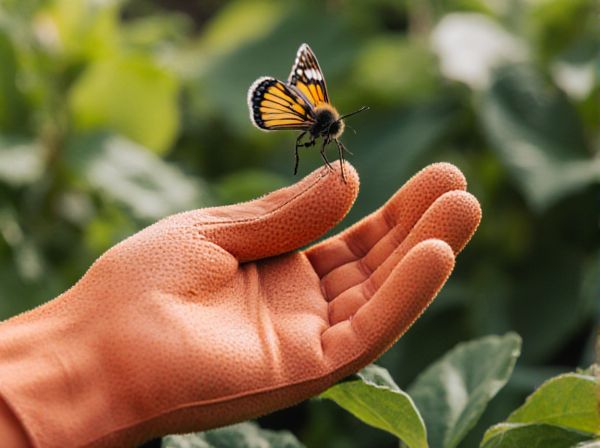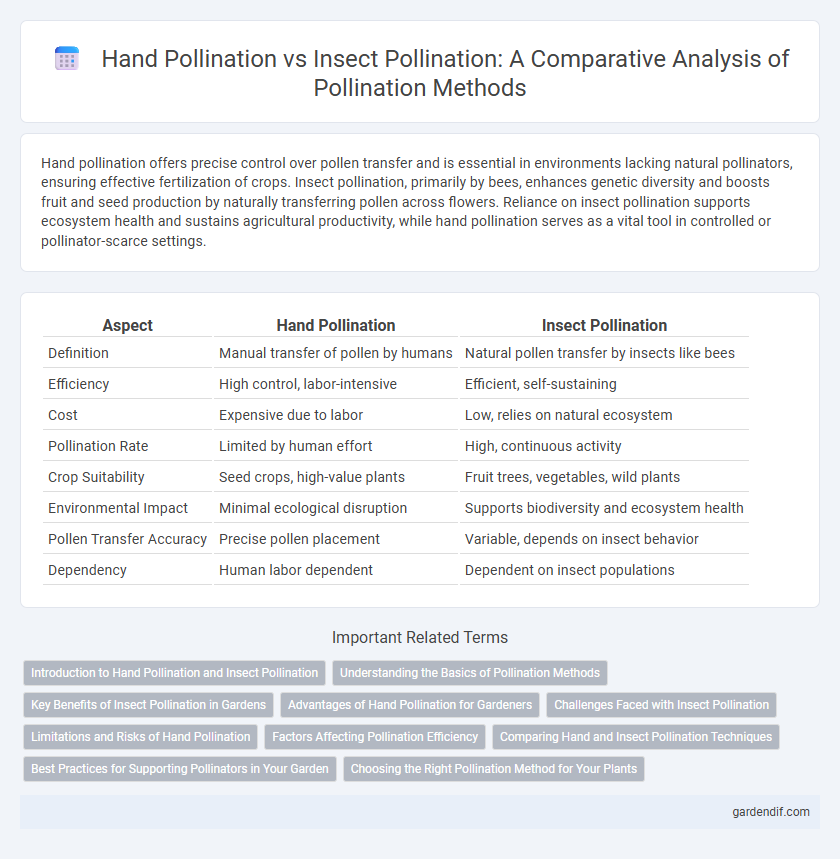
Hand Pollination vs Insect Pollination Illustration
Hand pollination offers precise control over pollen transfer and is essential in environments lacking natural pollinators, ensuring effective fertilization of crops. Insect pollination, primarily by bees, enhances genetic diversity and boosts fruit and seed production by naturally transferring pollen across flowers. Reliance on insect pollination supports ecosystem health and sustains agricultural productivity, while hand pollination serves as a vital tool in controlled or pollinator-scarce settings.
Table of Comparison
| Aspect | Hand Pollination | Insect Pollination |
|---|---|---|
| Definition | Manual transfer of pollen by humans | Natural pollen transfer by insects like bees |
| Efficiency | High control, labor-intensive | Efficient, self-sustaining |
| Cost | Expensive due to labor | Low, relies on natural ecosystem |
| Pollination Rate | Limited by human effort | High, continuous activity |
| Crop Suitability | Seed crops, high-value plants | Fruit trees, vegetables, wild plants |
| Environmental Impact | Minimal ecological disruption | Supports biodiversity and ecosystem health |
| Pollen Transfer Accuracy | Precise pollen placement | Variable, depends on insect behavior |
| Dependency | Human labor dependent | Dependent on insect populations |
Introduction to Hand Pollination and Insect Pollination
Hand pollination involves the manual transfer of pollen from the male anther to the female stigma using tools like brushes or cotton swabs, enabling controlled fertilization in crops such as vanilla, tomatoes, and certain fruit trees. Insect pollination relies on pollinators like bees, butterflies, and beetles to naturally transfer pollen while feeding on nectar, enhancing genetic diversity and ecosystem health. Both methods play crucial roles in agricultural productivity, with hand pollination serving as an essential technique in environments where natural pollinators are scarce or ineffective.
Understanding the Basics of Pollination Methods
Hand pollination involves manually transferring pollen from the male anther to the female stigma, ensuring controlled and targeted fertilization, especially in environments lacking adequate insect activity. Insect pollination relies on pollinators like bees, butterflies, and beetles that naturally transfer pollen while foraging, facilitating genetic diversity and ecosystem health. Understanding these methods highlights the balance between human intervention for crop yield optimization and the ecological benefits provided by natural pollinators.
Key Benefits of Insect Pollination in Gardens
Insect pollination enhances genetic diversity by enabling cross-pollination among a wide variety of plants, leading to healthier and more resilient garden ecosystems. It supports higher fruit and seed set rates compared to hand pollination because insects efficiently transfer pollen while foraging over large areas. Furthermore, insect pollination promotes natural biodiversity, attracting beneficial species that contribute to pest control and improved plant growth.
Advantages of Hand Pollination for Gardeners
Hand pollination offers gardeners precise control over the fertilization process, ensuring higher fruit set and quality in crops sensitive to inconsistent insect activity. This method is particularly advantageous in controlled environments like greenhouses or during poor weather conditions when pollinator insects are less active. By manually transferring pollen, gardeners can improve yield reliability and support the propagation of specific plant varieties that depend on selective pollination.
Challenges Faced with Insect Pollination
Insect pollination faces significant challenges including habitat loss, pesticide exposure, and climate change, all of which contribute to declining pollinator populations. Reduced biodiversity limits the availability of effective pollinators, impacting crop yields and ecosystem health. Furthermore, seasonal mismatches between flowering periods and pollinator activity disrupt the pollination process, threatening agricultural productivity.
Limitations and Risks of Hand Pollination
Hand pollination presents limitations such as increased labor costs, time consumption, and the risk of inconsistent pollen transfer, which can result in reduced fruit set and lower genetic diversity. Unlike insect pollination, which naturally ensures cross-pollination and biodiversity through diverse pollinator species, hand pollination may lead to inbreeding depression if pollen sources are not carefully managed. Additionally, manual pollination exposes crops to potential contamination and physical damage, making it less reliable on a large scale.
Factors Affecting Pollination Efficiency
Pollination efficiency depends on factors such as pollen transfer accuracy, environmental conditions, and pollinator behavior. Hand pollination allows precise control over pollen placement but is labor-intensive and less effective for large-scale crops. Insect pollination benefits from natural pollinator diversity and foraging patterns, enhancing genetic variation and crop yield under optimal habitat conditions.
Comparing Hand and Insect Pollination Techniques
Hand pollination allows precise control over pollen transfer, increasing success rates in controlled environments or when insect activity is low. Insect pollination, driven mainly by bees and butterflies, enhances genetic diversity and adapts naturally to various crops and ecosystems. While hand pollination supports targeted crop production, insect pollination offers sustainable, cost-effective pollination services essential for global food security.
Best Practices for Supporting Pollinators in Your Garden
Hand pollination involves manually transferring pollen between flowers, which can be effective for controlled breeding or in environments lacking natural pollinators. Insect pollination relies on bees, butterflies, and other pollinators that naturally transfer pollen while foraging, promoting genetic diversity and ecosystem health. To best support pollinators in your garden, plant diverse native flowering species, avoid pesticides harmful to insects, and provide habitat features like water sources and nesting sites.
Choosing the Right Pollination Method for Your Plants
Hand pollination offers precise control over fertilization, making it ideal for greenhouse crops or plants in environments lacking natural pollinators. Insect pollination provides efficient, natural transfer of pollen, essential for biodiversity and the production of fruits like apples, almonds, and blueberries. Selecting the right method depends on plant species, environmental conditions, and desired crop yield to optimize pollination success.
Hand Pollination vs Insect Pollination Infographic

 gardendif.com
gardendif.com